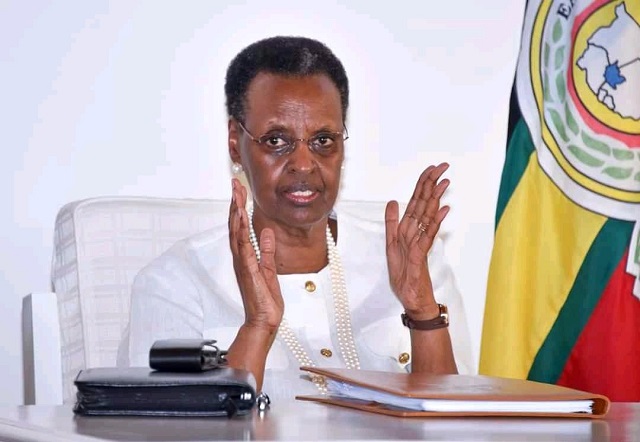
Kampala, Uganda | THE INDEPENDENT | Ugandans have questioned the ability of the Education Response Plan to ensure that Ugandan children can stay safe while still acquiring knowledge in the comfort of their homes during the COVID-19 lockdown.
The response plan is part of a framework outed by the Education Minister Janet Museveni proposing that lessons be delivered through print and self-study home packages, recorded lessons and live presentations on radio, television and online uploads to be sent to learners through mobile phones.
It came barely a month after the government announced the closure of schools on March 20 to forestall the spread of coronavirus disease-COVID-19, a measure which left up to 15 million learners stranded in homes across the country. But educationists, leaders and parents are arguing that the plan was not well thought out since many of the proposed interventions are being applied without a test of efficiency.
The self-study materials program championed by the National Curriculum Development Centre-NCDC has failed to yield results as many of the districts have reported receiving just a handful of materials. Wakiso district which has the highest number of learners in both secondary and primary schools received 24,964. Primary schools in the area are estimated to have over 400,000 pupils and secondary schools have a population of 120,000 students.
Mukono district received 1,000 copies to be circulated among 40,000 secondary school learners and 50,000 copies for a population of 100,000 learners. Kaberamaido district received 18,000 copies of self-study material against an estimated 75,000 learners while Soroti district and municipality received 39,824 copies, out of the 82,798 learners.
Kumi district received 4,000 out of 79,000, while in Bukomansimbi, one parish of Kawoko received only 481 copies out of a total of 5,129 students in primary and secondary schools who need the materials. The entire district of Mityana got 35 copies against a student population of 30,000 learners.
Mityana Resident District Commissioner Isha Ntumwa says the plan is self-defeating. Similarly, Bududa District Education Officer Betty Khainza says that the distribution of self-study materials is not feasible and might not yield anything for both the learners and the country.
Initially, the National Curriculum Development Centre had targeted 10.7 million children in primary, two million in pre-primary, and two million students in secondary schools and according to Dr Bernadette Nambi Karuhanga, the Deputy Director of the centre, they had to produce 12 million copies accounting for each learner. This was dependent on data from the Uganda Bureau of Statistics-UBOS.
But Moses Abonga, from Laroo Division in Gulu municipality says that the learning materials that have been supplied are inadequate given the huge number of learners that remains uncovered even after the distribution. He added that they even do not have a budget to facilitate the distribution.
Kelly Komakech, the chairperson of Pece Division in Gulu Municipality explains that the approach cannot be supported by the low level of literacy among some parents who are to supervise their children.
While waiting for the self-study materials, parents are equally disappointed that weeks after the release of the television and radio learning time table running from April 23 to May 16, the ministry is yet to identify the radio and televisions for the task. Instead, it had relied on the national broadcaster- Uganda Broadcasting Corporation.
But a random check-in Mityana district showed that a sizeable majority of the population has no idea about the UBC frequency in the area whose spectrum is dominated by community FM radio stations. Surait Mamo Ssengendo, a father of two, notes that it would be ideal to use local stations to reach wider audiences.
The Ministry of Education Spokesperson Patrick Muinda notes that given the fact that the plan was responding to an emergency, several things are being just tried for the first time. Muinda notes that they have decided that UBC locates the areas where its signals do not reach so that radio stations in those areas are incorporated into the programme. So far 38 radio stations have been identified to officially broadcast lessons to learners in the areas that are not covered by the UBC.
According to Geoffrey Osborn Oceng, an educationist in Gulu, the approach is deceptive because the method is technologically sophisticated and only beneficial to privileged Ugandans given the economic disparity in the country.
Lyandro Komakech, the Gulu Municipality MP indicates that the approach only aims at widening further the already existing inequality level among Ugandans.
Although the education ministry missed out on the COVID-19 supplementary budget, a source who preferred anonymity intimated that the ministry drafted a four trillion shillings budget to respond to the situation. The source however adds that the funds were not readily available and therefore they decided to start with an action budget of 28 billion Shillings.
Initial sources indicated that the Ministry of Education had spent 12 billion Shillings to print the self-study materials. However, Robert Kabushega, the Chief Executive Officer of Vision Group whose printing arm was contracted to print the material says that the company signed a contract worth 5.9 billion Shillings for the job.
The ministry is expecting to receive USD 20 million (approximately 76 billion shillings) education response and recovery grant from Global Partnership for Education. Countries like Rwanda and Zambia have already benefited from the same grant each getting USD 10 million.
******
URN
 The Independent Uganda: You get the Truth we Pay the Price
The Independent Uganda: You get the Truth we Pay the Price



